Battle of Cherbourg (1864)
The Battle of Cherbourg, or sometimes the Battle off Cherbourg or the Sinking of CSS Alabama, was a single-ship action fought during the American Civil War between a United States Navy warship, USS Kearsarge, and a Confederate States Navy warship, CSS Alabama, on June 19, 1864, off Cherbourg, France.
| Battle of Cherbourg | |||||||
|---|---|---|---|---|---|---|---|
| Part of the American Civil War | |||||||
 Sinking of the CSS Alabama (1922), by Xanthus Smith, Franklin D. Roosevelt Presidential Library, Hyde Park, New York | |||||||
| |||||||
| Belligerents | |||||||
|
|
| ||||||
| Commanders and leaders | |||||||
|
|
| ||||||
| Units involved | |||||||
| USS Kearsarge | CSS Alabama | ||||||
| Strength | |||||||
|
1 screw sloop-of-war 163 sailors[1] |
1 screw sloop-of-war 149 sailors[1] | ||||||
| Casualties and losses | |||||||
|
1 killed 2 wounded[2] |
1 ship sunk 19 died (9 KIA, 10 drowned)[1] 21 wounded[1] ~70 captured ~38 to 41 Confederate sailors were rescued by a British yacht and escaped capture. | ||||||
Background
After five successful commerce raiding missions in the Atlantic Ocean, CSS Alabama turned into Cherbourg Harbor on June 11, 1864. The Confederate States sloop-of-war was commanded by Captain Raphael Semmes, formerly of CSS Sumter. It was Captain Semmes' intention to drydock his ship and receive repairs at the French port(After 22 months of sailing the "Alabama" boilers were burned out; machinery needed repairs; loose at every joint and her copper bottom was in rolls[1]). The Confederate Navy vessel was crewed by about 149 men and armed with six 32-pounder (15 kg) cannon, mounted broadside, three guns per side, and two heavy pivot guns, mounted on the centerline and able to fire to either side: one 8-inch (203 mm), 110-pound (50 kg) smoothbore gun and one 7-inch (178 mm), 68-pound (31 kg) rifled gun. Alabama had been pursued for two years by the screw sloop-of-war USS Kearsarge, under Captain John Winslow. Kearsarge was armed with two 11-inch (279 mm) smoothbore Dahlgren guns which fired about 166 pounds of solid shot, four 32-pound guns and one 30-pounder Parrott rifle. She was crewed by around 163 sailors and officers.
Kearsarge had a form of makeshift armor-cladding, medium-weight chain cable triced in tiers along her port and starboard midsections, basically acting as the equivalent of chain mail for vulnerable sections of her hull, where shot could potentially penetrate and hit her boilers or steam engine. This armor protection potentially gave the Union warship a definitive advantage over the Confederate raider; however, the armor was only capable of stopping shots from Alabama's lighter 32-pound balls; either of her heavier guns could easily penetrate such lightweight protection. In the event, it was a moot point, as Alabama only managed to score two hits in this area, both of which were well above the waterline and the vulnerable engineering areas, and would have done little lasting damage even if they had successfully penetrated the hull.
On June 14, Kearsarge finally caught up with Alabama as she was receiving repairs. Kearsarge did not attack, as Alabama was in a neutral port; instead, she waited, initiating a blockade of CSS Alabama in Cherbourg. Union Captain Winslow telegraphed USS St. Louis to request her assistance, but the fighting began before she could arrive. Confederate Captain Semmes used the time to drill his men for the coming battle. On June 19, CSS Alabama, with nowhere else to go, ran up the Stars and Bars and exited the harbor to attack Kearsarge. She was escorted by the French Navy ironclad Couronne,[3] whose mission was to ensure that the ensuing battle occurred outside the French harbor.
Battle
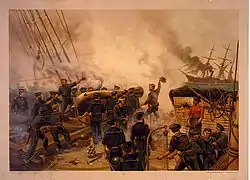
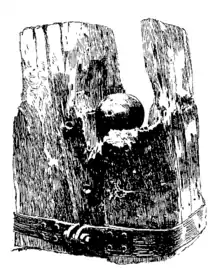
Captain Winslow spotted the departing Confederate raider, so they turned his ship around to take the impending battle out of French territorial waters. Once out, Kearsarge turned about again, hoisted the United States Navy Jack, and lined up for a broadside. Captain Winslow ordered his gunners to hold their fire until the range closed. CSS Alabama fired the first shots from the 100-pound pivot gun.[1] They are not known to have hit. Eventually Kearsarge was under way, and the range closed to within 1,000 yards (910 m) when she fired her first shot. The two warships maneuvered on opposite courses throughout the battle. Kearsarge and Alabama made seven spiraling circles around each other, moving southwest in a 3-knot (5.6 km/h; 3.5 mph) current. Both Captain Semmes and Captain Winslow attempted to cross each other's bow, hoping to inflict heavy raking fire. Three of the Kearsarge 11 inch shells entered the "Alabama"s 8 inch gun port.[1]The Alabama gunpowder was damaged and defective-her guns gave out a dull report with thick and heavy vapor while the "Kearsage" battery was clear and sharp with powder burning like thin vapor.[1] Likewise the "Alabama" fired too fast and high while the Kearsarge fired slow and steady.The battle continued in this manner for several minutes; in the meantime, on the French coast, hundreds watched the battle. Kearsarge's armor cladding sustained two hits during the engagement.
The first shell, a 32-pounder, struck within the starboard gangway. The shot cut part of the chain armor and dented the wooden planking underneath.[4] The second shot was again a 32-pounder that exploded and broke a link of the chain. Both hits struck the chain five feet above the waterline and therefore did not threaten the boilers or machinery. The gunnery of USS Kearsarge was reportedly more accurate than that of the Confederates. She fired slowly with well-aimed shots, while Alabama fired rapidly. CSS Alabama fired a total of over 370 rounds during the fighting; it is not known how many Kearsarge fired, but it is known that she fired many fewer than the Confederates did. Eventually, after just over an hour of exchanging artillery fire, Alabama had received shot-holes beneath the waterline from Kearsarge's Dahlgren guns and began to sink. Captain Semmes struck the Confederate colors, but still Kearsarge continued firing until a white flag was seen, raised by one of the Confederate sailors with his hand. The battle was over, so Captain Semmes sent his remaining dinghy to Captain Winslow, to ask for aid.
During the battle, 40 Confederate sailors were casualties (19 killed in action or drowned and 21 wounded). Another seventy or so were picked up by Kearsarge. Thirty or so were rescued by Deerhound, a British yacht, which Captain Winslow asked to help evacuate Alabama's crew, and three French pilot boats. Captain Semmes and fourteen of his officers were among the sailors rescued by Deerhound. Instead of delivering the captured Confederates to Kearsarge, Deerhound set a course for Southampton, thus enabling Captain Semmes' escape. This act severely angered Kearsarge's crew, who begged their captain to allow them to open fire on the British yacht. Captain Winslow would not allow this, so the Confederates got away and avoided imprisonment. Three men were wounded aboard the United States' vessel, one of whom died the following day.[5]
Aftermath
In art
For many years after the battle, Confederate Captain Semmes stated that he would never have chosen to test USS Kearsarge had he known of her armor-clad protection. CSS Alabama had destroyed or captured dozens of Union merchant vessels during her Atlantic cruises; when word of Alabama's sinking reached the northeastern United States, many Northerners were joyful. Édouard Manet produced two paintings of the fight, The Battle of the Kearsarge and the Alabama, now at the Philadelphia Museum of Art, and Kearsarge at Boulogne, now at the Metropolitan Museum of Art. American marine artist Xanthus Smith painted six versions of the naval battle. The most famous of these, a massive work exhibited at the 1876 Centennial Exposition, is in the collection of the Union League of Philadelphia.
The 37th album of Les Tuniques Bleues, titled Duel dans la Manche ("Duel in the Channel"), takes place during the Battle of Cherbourg, on USS Kearsarge.[6]
The battle was commemorated in the sea shanty "Roll, Alabama, Roll".
Wreck of Alabama
In November 1984, the French minesweeper Circé located the wreck of Alabama at a depth of 60 meters (200 ft), a little under 10 kilometers (5.4 nmi; 6.2 mi) north of the western approaches of Cherbourg roads (49°45′9″N 01°41′42″W).[7] Captain Max Guerout later confirmed that the wreck was that of Alabama.
In 1988, a nonprofit organisation named the CSS Alabama Association[8] was created to conduct a scientific survey of the wreck. Although it now lies in French territorial waters, the U.S. government claimed possession of it on the grounds that Alabama had struck to Kearsarge and that the location had not been within French territorial waters at the time of the battle. On 3 October 1989, France and the United States signed an agreement recognising the wreck as a common historic heritage for both nations and established a joint scientific team for its exploration.
On 23 March 1995, the CSS Alabama Association and the Naval History & Heritage Command signed an agreement to accredit the association for the archeological survey of Alabama. In 2002, over 300 samples were recovered, including the ship's bell, guns, part of the ship's structure, furniture, and tableware. In 2004, a human jaw was found under a gun and was subsequently buried in Mobile, Alabama.
See also
- Bahia Incident
- Battle of Havana (1870)
- SS Cantabria
- William B. Poole, Medal of Honor recipient for service on board the U.S.S. Kearsarge in the battle
Gallery
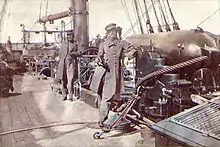
 Deck scene Cruiser Alabama in August, 1863 - Lts Armstrong and Sinclair at Sinclair's 32 pounder station[10]
Deck scene Cruiser Alabama in August, 1863 - Lts Armstrong and Sinclair at Sinclair's 32 pounder station[10].jpg.webp) USS Kearsarge, in an 1861 photograph
USS Kearsarge, in an 1861 photograph_deck.jpg.webp) The deck of Kearsarge after her engagement with CSS Alabama
The deck of Kearsarge after her engagement with CSS Alabama Crew of the USS Kearsarge in 1864 after the battle; showing both 11 Inch guns pointed to starboard as they were during the battle.
Crew of the USS Kearsarge in 1864 after the battle; showing both 11 Inch guns pointed to starboard as they were during the battle._(14759843311).jpg.webp) Firing the forward 11 inch gun on the Kearsarge
Firing the forward 11 inch gun on the Kearsarge_(14576197040).jpg.webp) The aft 11 inch gun on the Kearsarge used against the CSS Alabama[11]
The aft 11 inch gun on the Kearsarge used against the CSS Alabama[11]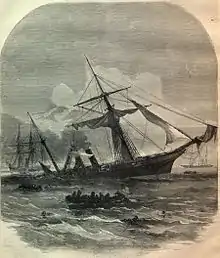 Sinking of the CSS Alabama, engraving, Harper's Weekly Magazine, 23 July 1864
Sinking of the CSS Alabama, engraving, Harper's Weekly Magazine, 23 July 1864 The Fight between the Alabama and the Kearsarge, 1864 engraving
The Fight between the Alabama and the Kearsarge, 1864 engraving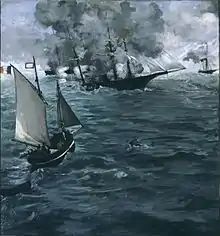
 The Kearsarge at Boulogne (1864), by Édouard Manet, Metropolitan Museum of Art
The Kearsarge at Boulogne (1864), by Édouard Manet, Metropolitan Museum of Art The Sinking of the CSS Alabama, unidentified artist
The Sinking of the CSS Alabama, unidentified artist Engraving by Louis Le Breton (by 1866)
Engraving by Louis Le Breton (by 1866) Replica of USS Kearsarge on display at the 1893 Grand Army of the Republic national convention in Indianapolis, Indiana
Replica of USS Kearsarge on display at the 1893 Grand Army of the Republic national convention in Indianapolis, Indiana USS Kearsarge in Battle (1936), by Jo Davidson, Franklin D. Roosevelt Presidential Library
USS Kearsarge in Battle (1936), by Jo Davidson, Franklin D. Roosevelt Presidential Library CSS Alabama (1961), by J.W. Schmidt, Naval History and Heritage Command
CSS Alabama (1961), by J.W. Schmidt, Naval History and Heritage Command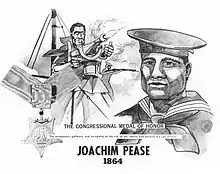 U.S. Navy recruiting poster highlighting Joachim Pease, 1970s
U.S. Navy recruiting poster highlighting Joachim Pease, 1970s
Notes
- On authority of CSS Alabama Executive master John McIntosh Kell "Cruise and Combats of the Alabama" Johnson & Buel 1888, Vol. IV, p. 614
- Seaman William Gowin died of wounds; two others wounded. Ref: Johnson & Buel 1888, Vol. IV, pp. 622–623
- Combat naval à Cherbourg (1864), Wikimanche
- Fox, Stephen (2007). Wolf of the Deep: Raphael Semmes and the Notorious Confederate Raider CSS Alabama. New York: Alfred A. Knopf. p. 211. ISBN 978-1400044290.
- Johnson & Buel 1888, pp. 622–623
- "37. Duel dans la Manche". Les Tuniques Bleues.
- Épave de l'Alabama, Cherbourg 1864, Centre européen de recherches et d'études sous-marines
- "CSS Alabama Association". Archived from the original on 2004-09-24. Retrieved 2015-09-03.
- "NH 57256-KN CSS Alabama (1862-1864)". Naval History and Heritage Command.
- Sinclair, Arthur, Lt. CSN (1896). Two Years on the Alabama. Boston: Lee and Shepard Publishers.
{{cite book}}: CS1 maint: multiple names: authors list (link) - "NH 52029 USS Kearsarge (1862-1894)". Naval History and Heritage Command. Retrieved 1 January 2019.
References
- Bowcock, Andrew (2002). CSS Alabama, Anatomy of a Confederate Raider. London, UK: Chatham Publishing. p. 191. ISBN 9781861761897. OCLC 48931829.
- Delaney, Norman C. (1973), ""Old Beeswax": Raphael Semmes of the Alabama", Civil War Times Illustrated, XII (8): 12, OCLC 671281286
- Gindlesperger, James (2003). Fire on the Water: The USS Kearsarge and the CSS Alabama. Shippensburg, PA: Burd Street Press. p. 333. ISBN 9781572493063. OCLC 52071690.
- Hearn, Chester G. (1992). Gray Raiders of the Sea: How Eight Confederate Warships Destroyed the Union's High Seas Commerce. Camden, ME: International Marine Pub. p. 351. hdl:2027/mdp.39015024988779. ISBN 9780807121146. OCLC 36205979.
- Johnson, R.U.; Buel, C.C., eds. (1888). Battles and Leaders of the Civil War. Vol. IV. New York: The Century Company.
- Luraghi, Raimondo (1996). A History of the Confederate Navy. Annapolis, MD: U. S. Naval Institute Press. p. 514. ISBN 1557505276. OCLC 682950313.
- Madaus, H. Michael (1986), "Rebel Flags Afloat: A Survey of the Surviving Flags of the Confederate States Navy, Revenue Service, and Merchant Marine", The Flag Bulletin, Winchester, MA: Flag Research Center (115), ISSN 0015-3370, OCLC 185432467
- Marvel, William (1996). The Alabama & the Kearsarge: The Sailor's Civil War. Civil War America. Chapel Hill, NC: University of North Carolina Press. p. 337. ISBN 9780807866900. OCLC 47010328.
- Roberts, Arthur C., M.D. (1999), "Reconstructing USS Kearsarge, 1864", Nautical Research Journal, Silver Springs, MD, 44 (4), ISSN 0738-7245, OCLC 194781081
{{citation}}: CS1 maint: multiple names: authors list (link) - Semmes, Raphael, Admiral, CSN (1869). Memoirs of Service Afloat, During the War Between the States. Baltimore, MD: Kelly, Piet & Co. OCLC 1455940.
{{cite book}}: CS1 maint: multiple names: authors list (link) - Still, William N. Jr.; Taylor, John M.; Delaney, Norman C. (1998). Raiders & Blockaders: The American Civil War Afloat. Dulles, VA: Brassy's, Inc. p. 263. ISBN 9781574882384. OCLC 46768948.
- Winslow, John A., CAPT USN (1864). Gideon Welles, Secretary of the Navy (ed.). Sinking of the Alabama—Capture of the Georgia and Florida: Destruction of the Alabama by the Kearsarge. Annual Reports of the Navy Department: Report of the Secretary of the Navy, 1864. Washington, DC: U.S. Government Printing Office. p. 863. OCLC 2480810.
{{cite book}}: CS1 maint: multiple names: authors list (link)